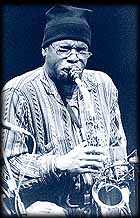
|
|
|
|
|
|
Photo Credit: Tim Owens |
Antonio Hart
Alto saxophonist Antonio Hart plays with fire, sensitivity and passion. His distinctive sound combines various elements spanning the history of jazz, which he has absorbed and synthesized through years of study. But Hart is also at home on the bandstand, where he often joins the likes of Nat Adderley, Roy Hargrove and, more recently, his own ensemble. An excited audience at The Kennedy Centerís Theater Lab offers Hart a warm welcome, as he launches into "All Godís Children Got Rhythm". Hart grew up in Baltimore and started learning saxophone in elementary school. He recalls being drawn to the instrument in music class, and says, "I had a passion, a love for music." After continuing lessons through junior high, he attended a local performing arts high school, where he studied European classical music. Hart feels that this experience made a vital contribution to his technical development as a musician and his understanding of harmony. However, Hart did not see performing Western classical music as an avenue for his own personal expression. "I felt the composer wrote everything he wanted on the page, and left little room for self-expression." At the same time, Hart was listening to a local jazz radio station, and discovering saxophonists like Charlie Parker, John Coltrane and Sonny Stitt. Before long, studying jazz had become his priority. Hart attended Berklee School of Music in Boston, which is noted for the prominent jazz artists among its faculty and alumni. Upon graduating, he pursued a masters degree at Queens College, where he studied under saxophonist Jimmy Heath and trumpeter Donald Byrd. Hart wanted to study directly under the guidance of such masters, who had "helped add something to the music." Hart says he has focused much of his study on players who preceded Charlie Parker, such as Johnny Hodges, Benny Carter, Ben Webster and Lester Young. These early players strove to "imitat[e] the voice" and make the saxophone "sing". Hart takes this approach in his own direction with his composition, "Rabbit", a tribute to Hodges. Citing Earl Bostic as another important influence, Hart demonstrates Bosticís use of special fingering techniques to expand the range of his saxophone. Hart then plays his own unique rendition of Bosticís "Flamingo". Responding to questions from the audience, Hart expresses concern that the younger generation is overlooking jazz music, despite its many different periods and diversity of styles. He laments, "a lot of people are lettingÖgreat music go by without giving it a chance."
Hart also shares his approach to composing music, noting that it varies from song to song. He says "Rabbit" evolved from a bass line, followed by harmony and melody, but was ultimately inspired by the feeling Hart gets from the music and images of Hodges himself. Hart then closes the show with a riveting rendition of another original composition, "Tears for Bosnia", which he says was inspired by televised images of people suffering the tragedy of war.
|
|
| |
